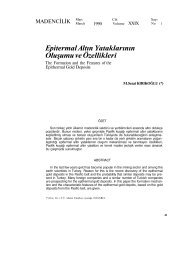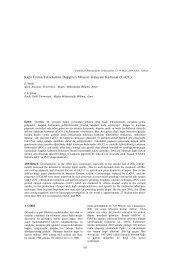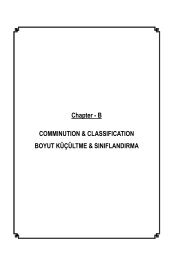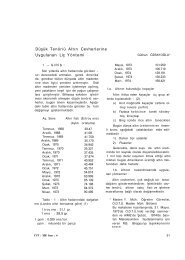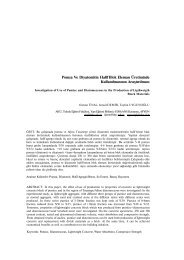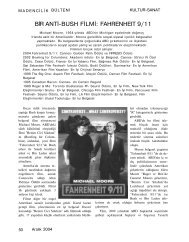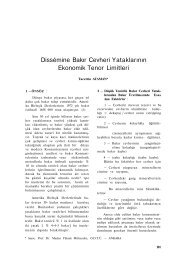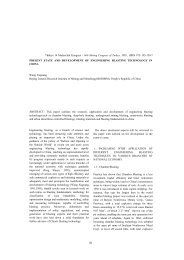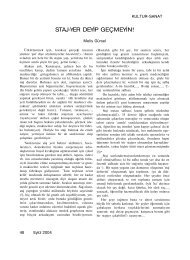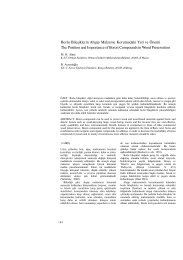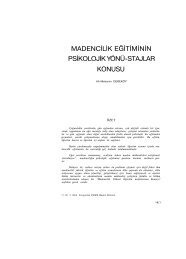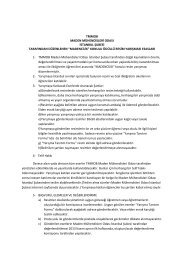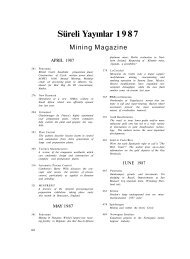A OPEN PIT MINING AÇIK OCAK MADENCİLİĞİ
A OPEN PIT MINING AÇIK OCAK MADENCİLİĞİ
A OPEN PIT MINING AÇIK OCAK MADENCİLİĞİ
You also want an ePaper? Increase the reach of your titles
YUMPU automatically turns print PDFs into web optimized ePapers that Google loves.
3 HUB-LOCATION PROBLEM<br />
One of the new topics in location problems<br />
is the hub location problem. The first paper<br />
on hub location problem was published by<br />
Toh and Higgins (1985) and it was on the<br />
application of hub location problem in<br />
airlines and airports. A comprehensive<br />
survey on hub location models and problems<br />
can be found in Alumur and Kara 2008.<br />
Suppose that there are N nodes and if each<br />
node can be either an origin or a destination,<br />
then there are N(N-1) origin-destination<br />
pairs of nodes in the network. Notice that the<br />
pair i-j is different from the j-i pair. Figure 4<br />
shows a network with six nodes (Daskin,<br />
1995). Assume that in this network each<br />
vehicle could service five origin-destination<br />
pairs every day, and then with six vehicles,<br />
six nodes could be serviced every day.<br />
hub networks, instead of servicing each<br />
spoke directly, hub facilities concentrate<br />
flows in order to take advantage of<br />
economies of scale. Flows from a spoke are<br />
transported to the hub, and are combined<br />
with flows that have different origins but the<br />
same destination. This fact will reduce the<br />
total cost of transportation.<br />
In multi hub networks, the hub nodes are<br />
completely connected to one another and<br />
each spoke is connected to at least one hub<br />
such as the network shown in Figure 6<br />
(Hekmatfar and Pishvaee, 2009).<br />
Figure 6. Example of a 2-hub network<br />
Figure 4. A fully connected network (6<br />
nodes and 30 origin-destination pairs)<br />
If one of these nodes is set as a hub node<br />
and then connect it to all of the other nodes<br />
(which are called spoke), then there will be<br />
2(N-1) connections to service all the spokes<br />
via a hub node (Hekmatfar and Pishvaee,<br />
2009). This network is presented in figure 5<br />
and node A is supposed to be the hub node.<br />
Figure 5. A hub and spoke network<br />
(6 nodes with 6 origin-destination pairs)<br />
Again, if each vehicle could service five<br />
origin-destination pairs every day, then in<br />
this network, with six vehicles, 16 spokes<br />
could be serviced every day. Thus, with a<br />
fixed transportation capacity, it is possible to<br />
service more spokes within a hub network<br />
than within a fully connected network. In<br />
In multi hub networks the assumption is<br />
that, the hubs are connected through low<br />
cost and high capacity pathways which<br />
causes a discount on the transportation costs<br />
between a given hub pair (Naeem, 2009).<br />
The advantage of using hubs is the gain of<br />
economic profits by establishing more<br />
qualitative paths between the hubs. It should<br />
be noted that, increasing transportation<br />
capacity could decrease transportation costs.<br />
On the other hand, increase of transportation<br />
capacity is not possible on every path,<br />
because traffic of the path will become an<br />
important issue in this case. Introducing hub<br />
nodes can effectively solve this problem. It<br />
means that not only transportation capacity<br />
increases, but also there is a low traffic<br />
problem as compared to the situation where<br />
there is not a hub node. Alumur et. al (2012)<br />
studied the hub location problem in the<br />
presence of uncertainty about the set-up<br />
costs for the hubs and the demands to be<br />
transported between the spokes.<br />
4 MATHEMATICAL MODEL OF HUB-<br />
LOCATION PROBLEM<br />
The hub-location problem involves<br />
locating facilities and hub (or hubs) in a<br />
144



